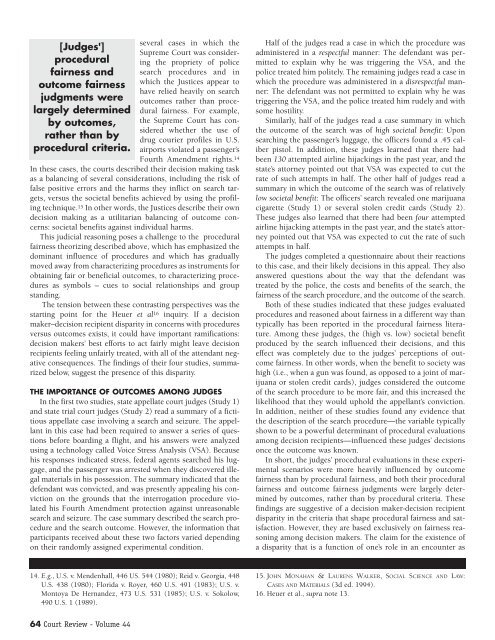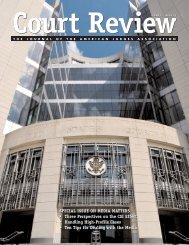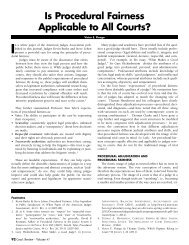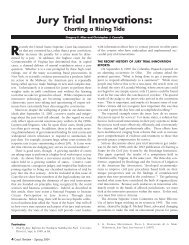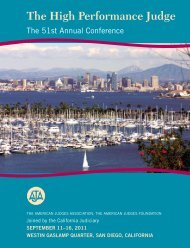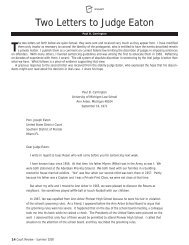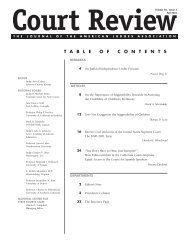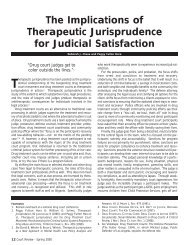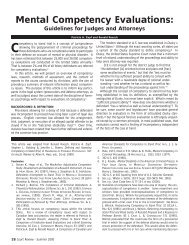Special Issue on Procedural Fairness - American Judges Association
Special Issue on Procedural Fairness - American Judges Association
Special Issue on Procedural Fairness - American Judges Association
- No tags were found...
Create successful ePaper yourself
Turn your PDF publications into a flip-book with our unique Google optimized e-Paper software.
[<strong>Judges</strong>']proceduralfairness andoutcome fairnessjudgments werelargely determinedby outcomes,rather than byprocedural criteria.several cases in which theSupreme Court was c<strong>on</strong>sideringthe propriety of policesearch procedures and inwhich the Justices appear tohave relied heavily <strong>on</strong> searchoutcomes rather than proceduralfairness. For example,the Supreme Court has c<strong>on</strong>sideredwhether the use ofdrug courier profiles in U.S.airports violated a passenger’sFourth Amendment rights. 14In these cases, the courts described their decisi<strong>on</strong> making taskas a balancing of several c<strong>on</strong>siderati<strong>on</strong>s, including the risk offalse positive errors and the harms they inflict <strong>on</strong> search targets,versus the societal benefits achieved by using the profilingtechnique. 15 In other words, the Justices describe their owndecisi<strong>on</strong> making as a utilitarian balancing of outcome c<strong>on</strong>cerns:societal benefits against individual harms.This judicial reas<strong>on</strong>ing poses a challenge to the proceduralfairness theorizing described above, which has emphasized thedominant influence of procedures and which has graduallymoved away from characterizing procedures as instruments forobtaining fair or beneficial outcomes, to characterizing proceduresas symbols – cues to social relati<strong>on</strong>ships and groupstanding.The tensi<strong>on</strong> between these c<strong>on</strong>trasting perspectives was thestarting point for the Heuer et al 16 inquiry. If a decisi<strong>on</strong>maker–decisi<strong>on</strong> recipient disparity in c<strong>on</strong>cerns with proceduresversus outcomes exists, it could have important ramificati<strong>on</strong>s:decisi<strong>on</strong> makers’ best efforts to act fairly might leave decisi<strong>on</strong>recipients feeling unfairly treated, with all of the attendant negativec<strong>on</strong>sequences. The findings of their four studies, summarizedbelow, suggest the presence of this disparity.THE IMPORTANCE OF OUTCOMES AMONG JUDGESIn the first two studies, state appellate court judges (Study 1)and state trial court judges (Study 2) read a summary of a fictitiousappellate case involving a search and seizure. The appellantin this case had been required to answer a series of questi<strong>on</strong>sbefore boarding a flight, and his answers were analyzedusing a technology called Voice Stress Analysis (VSA). Becausehis resp<strong>on</strong>ses indicated stress, federal agents searched his luggage,and the passenger was arrested when they discovered illegalmaterials in his possessi<strong>on</strong>. The summary indicated that thedefendant was c<strong>on</strong>victed, and was presently appealing his c<strong>on</strong>victi<strong>on</strong><strong>on</strong> the grounds that the interrogati<strong>on</strong> procedure violatedhis Fourth Amendment protecti<strong>on</strong> against unreas<strong>on</strong>ablesearch and seizure. The case summary described the search procedureand the search outcome. However, the informati<strong>on</strong> thatparticipants received about these two factors varied depending<strong>on</strong> their randomly assigned experimental c<strong>on</strong>diti<strong>on</strong>.Half of the judges read a case in which the procedure wasadministered in a respectful manner: The defendant was permittedto explain why he was triggering the VSA, and thepolice treated him politely. The remaining judges read a case inwhich the procedure was administered in a disrespectful manner:The defendant was not permitted to explain why he wastriggering the VSA, and the police treated him rudely and withsome hostility.Similarly, half of the judges read a case summary in whichthe outcome of the search was of high societal benefit: Up<strong>on</strong>searching the passenger’s luggage, the officers found a .45 caliberpistol. In additi<strong>on</strong>, these judges learned that there hadbeen 130 attempted airline hijackings in the past year, and thestate’s attorney pointed out that VSA was expected to cut therate of such attempts in half. The other half of judges read asummary in which the outcome of the search was of relativelylow societal benefit: The officers’ search revealed <strong>on</strong>e marijuanacigarette (Study 1) or several stolen credit cards (Study 2).These judges also learned that there had been four attemptedairline hijacking attempts in the past year, and the state’s attorneypointed out that VSA was expected to cut the rate of suchattempts in half.The judges completed a questi<strong>on</strong>naire about their reacti<strong>on</strong>sto this case, and their likely decisi<strong>on</strong>s in this appeal. They alsoanswered questi<strong>on</strong>s about the way that the defendant wastreated by the police, the costs and benefits of the search, thefairness of the search procedure, and the outcome of the search.Both of these studies indicated that these judges evaluatedprocedures and reas<strong>on</strong>ed about fairness in a different way thantypically has been reported in the procedural fairness literature.Am<strong>on</strong>g these judges, the (high vs. low) societal benefitproduced by the search influenced their decisi<strong>on</strong>s, and thiseffect was completely due to the judges’ percepti<strong>on</strong>s of outcomefairness. In other words, when the benefit to society washigh (i.e., when a gun was found, as opposed to a joint of marijuanaor stolen credit cards), judges c<strong>on</strong>sidered the outcomeof the search procedure to be more fair, and this increased thelikelihood that they would uphold the appellant’s c<strong>on</strong>victi<strong>on</strong>.In additi<strong>on</strong>, neither of these studies found any evidence thatthe descripti<strong>on</strong> of the search procedure—the variable typicallyshown to be a powerful determinant of procedural evaluati<strong>on</strong>sam<strong>on</strong>g decisi<strong>on</strong> recipients—influenced these judges’ decisi<strong>on</strong>s<strong>on</strong>ce the outcome was known.In short, the judges’ procedural evaluati<strong>on</strong>s in these experimentalscenarios were more heavily influenced by outcomefairness than by procedural fairness, and both their proceduralfairness and outcome fairness judgments were largely determinedby outcomes, rather than by procedural criteria. Thesefindings are suggestive of a decisi<strong>on</strong> maker-decisi<strong>on</strong> recipientdisparity in the criteria that shape procedural fairness and satisfacti<strong>on</strong>.However, they are based exclusively <strong>on</strong> fairness reas<strong>on</strong>ingam<strong>on</strong>g decisi<strong>on</strong> makers. The claim for the existence ofa disparity that is a functi<strong>on</strong> of <strong>on</strong>e’s role in an encounter as14. E.g., U.S. v. Mendenhall, 446 US. 544 (1980); Reid v. Georgia, 448U.S. 438 (1980); Florida v. Royer, 460 U.S. 491 (1983); U.S. v.M<strong>on</strong>toya De Hernandez, 473 U.S. 531 (1985); U.S. v. Sokolow,490 U.S. 1 (1989).15. JOHN MONAHAN & LAURENS WALKER, SOCIAL SCIENCE AND LAW:CASES AND MATERIALS (3d ed. 1994).16. Heuer et al., supra note 13.64 Court Review - Volume 44


